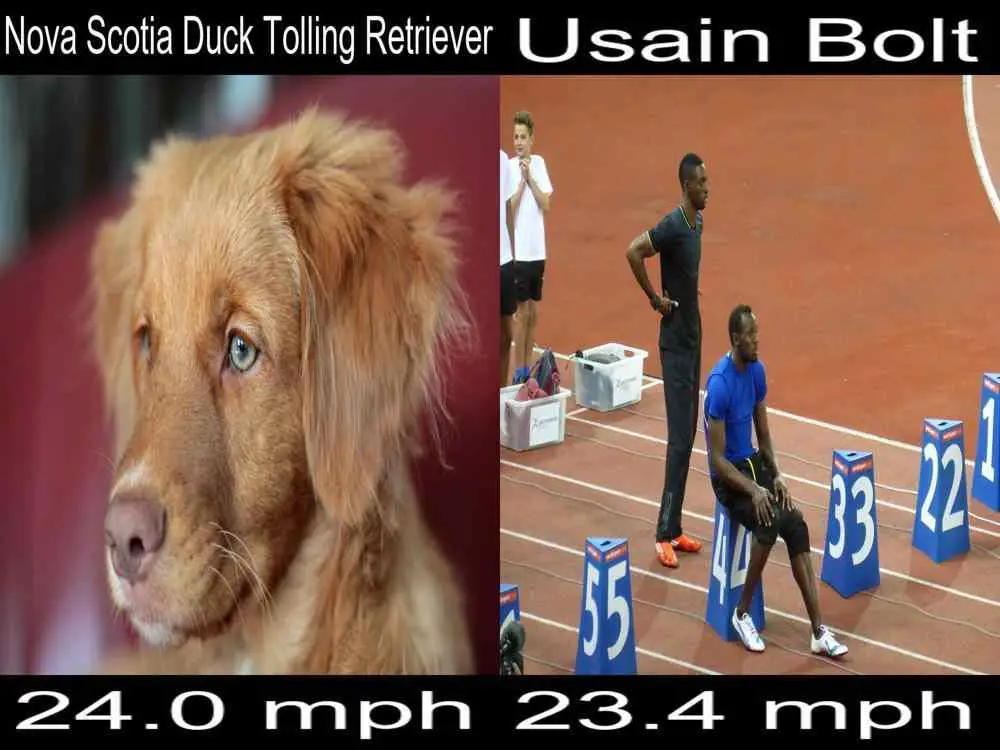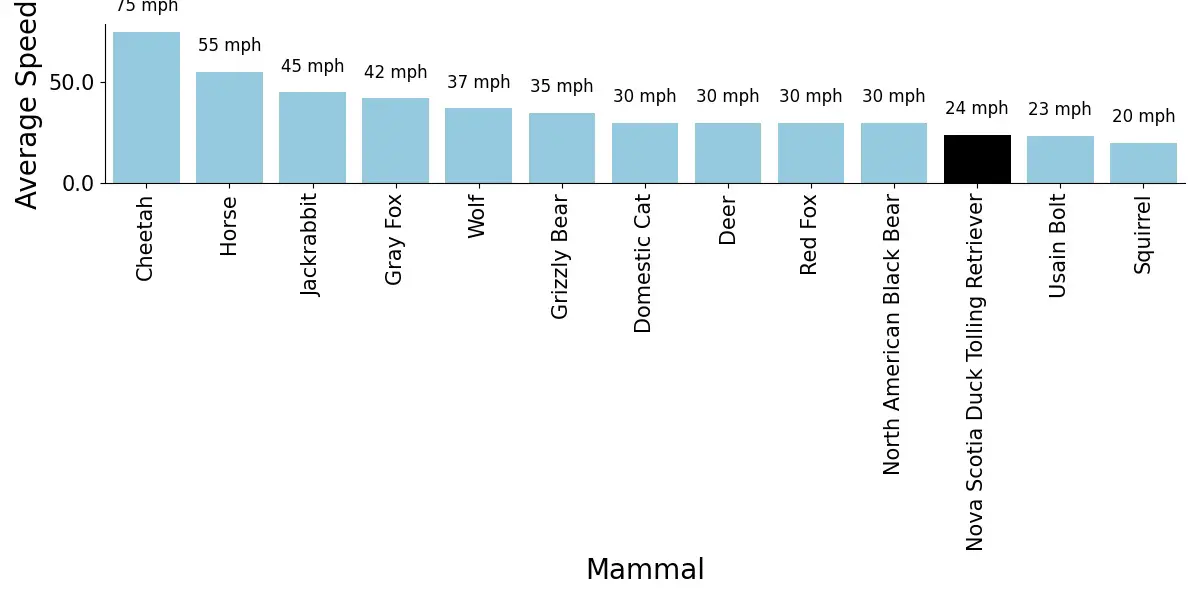Quick Links: Table of Contents
- Nova Scotia Duck Tolling Retriever Breed Overview
- History of the Nova Scotia Duck Tolling Retriever Breed. Where Nova Scotia Duck Tolling Retrievers came from
- What the Nova Scotia Duck Tolling Retriever Looks Like
- Best Nova Scotia Duck Tolling Retriever Breeders
- Adopting or Rescuing the Nova Scotia Duck Tolling Retriever
- What Colors do Nova Scotia Duck Tolling Retrievers Have?
- The Temperament of the Nova Scotia Duck Tolling Retriever
- Nova Scotia Duck Tolling Retriever Litter Size
- How Fast Nova Scotia Duck Tolling Retrievers Can Run
- Good Names for Nova Scotia Duck Tolling Retrievers
- How Popular are Nova Scotia Duck Tolling Retrievers with New Dog Owners?
- Health Problems in Nova Scotia Duck Tolling Retrievers and How to Prevent Them
- Dog Breeds That Are Similar to Nova Scotia Duck Tolling Retrievers
- Other Things to Know About Nova Scotia Duck Tolling Retrievers
Nova Scotia Duck Tolling Retriever Breed Overview
The Nova Scotia Duck Tolling Retriever is a medium-sized dog.
The adult Nova Scotia Duck Tolling Retriever stands 1 foot, 5 inches to 1 foot, 9 inches tall at the s.
The Nova Scotia Duck Tolling Retriever belongs to the Sporting Dogs group.
Dogs in the Sporting Dogs group, like the Nova Scotia Duck Tolling Retriever, were bred to help hunters catch and retrieve feathered game. Some sporting dog breeds such as Retrievers, which were built for swimming, were bred to hunt waterfowl in water.
Whereas sporting dog breeds like setters, spaniels, and pointing breeds were bred to hunt quail, pheasant, and other game birds nest on grasslands.
Many Sporting Group breeds have thick, water-repellent coats that protect them from harsh hunting conditions.
The fact that the Nova Scotia Duck Tolling Retriever belongs to the Sporting Dogs group is one of the reasons why Nova Scotia Duck Tolling Retrievers have the personality and temperament that they have.
The temperament of the Nova Scotia Duck Tolling Retriever is generally described as:
- Alert
- Intelligent
- Loving
- Outgoing
- Patient
History of the Nova Scotia Duck Tolling Retriever Breed. Where Nova Scotia Duck Tolling Retrievers came from
The first “tollers” were documented by the Micmac Indians of Canada.
These tollers were cunning foxes who patrolled the shores of rivers and lakes, snatching ducks that came too close to the shore.
The Micmac Indians began encouraging their own dogs to lure the ducks closer in the same way that the foxes did.
Some researchers believe these dogs are related to the Nova Scotia Duck Tolling Retriever.
Hunters in Yarmouth County, located in southwest Nova Scotia`s Little River district, developed a dog that could attract and retrieve ducks from the water.
These hunters started combining hunting and retrieving dogs like the Golden Retriever, Flat-Coated Retriever, Cocker Spaniel, and Irish Setter.
Some researchers believe that farm Collies made their way into the bloodlines as well.
The resulting dogs were red and were known as Little River Duck Dogs.
Until 1945, when the Canadian Kennel Club (CKC) officially recognized the breed and renamed him the Nova Scotia Duck Tolling Retriever, these dogs were virtually unknown in other parts of Canada.
The first Tollers were imported into the United States in the 1960s, but they were unheard of until the late 1970s and early 1980s.
The Nova Scotia Duck Tolling Retriever Club of the United States was founded in 1984.
The American Kennel Club did not accept the Toller into its Foundation Stock Service until 2001, and he was only officially recognized as a dog in 2003.
.
What the Nova Scotia Duck Tolling Retriever Looks Like
When working or playing, the Nova Scotia Duck Tolling Retriever is a medium-sized dog with an alert expression.
His eyes are slightly oblique, almond-shaped, and spaced apart.
His eyes should be brown or a color that blends with his coat, with black or self-colored rims.
His nose and lips can be black or natural.
He has a medium-length water-resistant double coat with a slightly dense undercoat that is soft to the touch.
His coat is mostly straight, with a slight wave on his back.
There may be loose curls at his throat when he is wearing his winter coat, which is denser.
.
Best Nova Scotia Duck Tolling Retriever Breeders

We have researched reputable Nova Scotia Duck Tolling Retriever breeders that you can buy a puppy.
Go to this page for our complete list of reputable Nova Scotia Duck Tolling Retriever breeders in various states in the United States.
On this page, you will see how much these breeders sell their puppies for, and how many puppies they have available.
A few of these breeders are listed below.
Shallazar
Puppy Price: Check with breeder
TnT Tollers
Puppy Price: Check with breeder
Cyon Tollers
Puppy Price: Check with breeder
Weldon Ridge Ranch
Puppy Price: Check with breeder
Skylark Tollers
Puppy Price: Check with breeder
Adopting or Rescuing the Nova Scotia Duck Tolling Retriever
You may consider adopting a dog instead of buying a puppy. Many dogs, Nova Scotia Duck Tolling Retrievers included, are currently available for adoption in your local dog shelters.
These helpless but adorable dogs are waiting in dog shelters hoping that someday someone will rescue them. Dog adoption costs are lesser than the cost of a new puppy. Dog adoption costs are usually around $300 or even less.
In addition to your local dog shelter, another good place to find dogs that are available for adoption is petfinder.com.
Below is an adorable Male Nova Scotia Duck Tolling Retriever named Rocco that is currently available for adoption on Petfinder.com. You can find other lovely Nova Scotia Duck Tolling Retrievers like Rocco on pefinder.com.

You can find more Nova Scotia Duck Tolling Retrievers that are available for adoption on petfinder.

What Colors do Nova Scotia Duck Tolling Retrievers Have?
Nova Scotia Duck Tolling Retrievers come in the following beautiful primary colors:
- Brown / Chocolate
- Yellow / Tan / Blond / Fawn

The Temperament of the Nova Scotia Duck Tolling Retriever
The temperament of the Nova Scotia Duck Tolling Retriever based can be summarized as in the table below.
The table shows the scores of the Nova Scotia Duck Tolling Retriever for 13 important dog behavioral factors.
We obtained these scores by analyzing raw data from the C-BARQ dog personality survey tool. The higher the score of a dog for a factor, the worse the temperament of the dog regarding that factor.
The C-BARQ tool was developed by researchers from the University of Pennsylvania, and it is a scientific tool that is used worldwide for reliably measuring the temperament of dog breeds.
See our complete analysis of the temperament of the Nova Scotia Duck Tolling Retriever here.
| Factor | Score |
|---|---|
| Energy Level | 67.5 percent |
| Owner Directed Aggression | 6.4 percent |
| Prey Drive | 50.2 percent |
| Excitability | 44.4 percent |
| Stubbornness | 4.7 percent |
| Touch Sensitivity | 29.3 percent |
| Dog Rivalry | 29.1 percent |
| Attachment Attention Seeking | 26.2 percent |
| Dog Directed Aggression | 19.3 percent |
| Stranger Directed Fear | 16.7 percent |
| Stranger Directed Aggression | 16.3 percent |
| Separation Related Behavior | 15.6 percent |
| Dog Directed Fear | 12.9 percent |
| Nonsocial Fear | 12.0 percent |


Nova Scotia Duck Tolling Retriever Litter Size
Researchers from the Norwegian School of Veterinary Science did a study where they counted the numbers of puppies in 74 different Nova Scotia Duck Tolling Retriever birth litters.
From this study, the researchers found that the average number of puppies that Nova Scotia Duck Tolling Retrievers can have is 6 puppies. Also, the Nova Scotia Duck Tolling Retriever can have as few as 2 puppies per litter and as many as 12 puppies per litter.
The number of puppies that the Nova Scotia Duck Tolling Retriever will have depends on factors such as the age of the Nova Scotia Duck Tolling Retriever, the method of pregnancy, etc.
Click here to see our calculator for predicting how many puppies your Nova Scotia Duck Tolling Retriever will have and how the litter size of the Nova Scotia Duck Tolling Retriever compares to the litter size of other dog breeds.
How Fast Nova Scotia Duck Tolling Retrievers Can Run

How fast a dog breed can run is a good measure of how athletic the dog breed is.
The American Kennel Club (AKC) regularly conducts dog running competitions. The AKC records the running speed of competing dogs in these competitions. These competitions are open to all dog breeds.
Based on our analysis of the speeds of 186 different Nova Scotia Duck Tolling Retrievers, the average speed of the Nova Scotia Duck Tolling Retriever is 24.0 mph (38.7 kmph).
The fastest speed on AKC record that the Nova Scotia Duck Tolling Retriever ran in a race is 38.09 mph (61.3 kmph) and the minimum speed on record in a race for a Nova Scotia Duck Tolling Retriever is 6.02 mph (9.7 kmph).
Click here to see how the speed of the Nova Scotia Duck Tolling Retriever compares to the speed of other dogs and other mammals such as cats, horses, humans, etc.

Good Names for Nova Scotia Duck Tolling Retrievers
Here are some really good names that are typical for the Nova Scotia Duck Tolling Retriever ranked by popularity:
- Bowie
- Zeppelin
- Rocco


How Popular are Nova Scotia Duck Tolling Retrievers with New Dog Owners?
Every year, the American Kennel Club (AKC) publishes information on how popular a dog breed is in that particular year. The AKC gets the popularity information of a breed from how many dogs of that breed the owners register with the AKC every year. The AKC collects this data for about 200 dog breeds.
The graph below shows the popularity trend of the Nova Scotia Duck Tolling Retriever.
The popularity of the Nova Scotia Duck Tolling Retriever averaged over the years is Number 91 out of about 200 dog breeds.
Do not get a dog breed just because it is a popular dog breed. And do not reject a dog breed just because it is an unpopular breed.

Health Problems in Nova Scotia Duck Tolling Retrievers and How to Prevent Them
Every dog breed has its own set of health problems that it tends to develop. There is nothing like a perfect dog breed.
The Nova Scotia Duck Tolling Retriever is prone to certain genetic health conditions. The Orthopedic Foundation for Animals (OFA) is an organization that keeps track of genetic health problems in dog breeds.
From the extensive records that the OFA keeps, the OFA knows what health problems each dog breed is naturally prone to develop.
Hence, the OFA recommends which health screening breeders should perform on a dog breed to make sure that the breeders won`t breed `defective` dog parents that can pass down defective genes to their puppy offspring.
If you want a Nova Scotia Duck Tolling Retriever puppy that will grow up to be healthy, make sure that your Nova Scotia Duck Tolling Retriever breeder screens your puppy or your puppy`s parents for the health problems that the OFA recommends for your puppy`s breed. This will increase the chances that your puppy is free from genetic defects.
The following are the health tests that Orthopedic Foundation for Animals (OFA) recommends that breeders should screen Nova Scotia Duck Tolling Retrievers for:
You can find out more about OFA`s recommended tests for Nova Scotia Duck Tolling Retrievers here.

Dog Breeds That Are Similar to Nova Scotia Duck Tolling Retrievers
If you have not made up your mind on which dog breed to get, you may also want to consider some other dogs similar to the Nova Scotia Duck Tolling Retriever.
We crunched the numbers and found that the following dog breeds that have similar behavior and temperament as the Nova Scotia Duck Tolling Retriever:
- Cairn Terrier (81 percent match with Nova Scotia Duck Tolling Retriever). Learn more about the Cairn Terrier here.
- English Cocker Spaniel (79 percent match with Nova Scotia Duck Tolling Retriever). Learn more about the English Cocker Spaniel here.
- Finnish Lapphund (78 percent match with Nova Scotia Duck Tolling Retriever). Learn more about the Finnish Lapphund here.

Other Things to Know About Nova Scotia Duck Tolling Retrievers
Here are some of the very important characteristics of the Nova Scotia Duck Tolling Retriever that you need to know about the Nova Scotia Duck Tolling Retriever breed:
